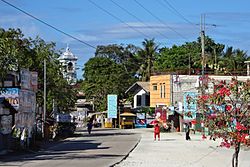Anda, Bohol
| Anda | |
|---|---|
| Municipality | |

Poblacion of Anda
|
|
 Map of Bohol with Anda highlighted |
|
| Location within the Philippines | |
| Coordinates: 9°45′N 124°34′E / 9.75°N 124.57°ECoordinates: 9°45′N 124°34′E / 9.75°N 124.57°E | |
| Country | Philippines |
| Region | Central Visayas (Region VII) |
| Province | Bohol |
| District | 3rd District of Bohol |
| Founded | 30 December 1872 |
| Barangay |
16 (see § Barangays)
|
| Government | |
| • Type | Sangguniang Bayan |
| • Mayor | Inday Simacio (PDP‑Laban) |
| • Vice mayor | Nilo Bersabal |
| • Town Council |
Members
|
| • Representative | Arthur Yap |
| Area | |
| • Total | 61.89 km2 (23.90 sq mi) |
| Population (2015 census) | |
| • Total | 16,462 |
| • Density | 270/km2 (690/sq mi) |
| • Voter (2016) | 11,852 |
| Time zone | PST (UTC+8) |
| ZIP code | 6311 |
| IDD : area code | +63 (0)38 |
| Income class | 5th class |
| PSGC | 071203000 |
| Website | www |
Anda is a 5th municipal income class municipality in the province of Bohol, Philippines. According to the 2015 census, it has a population of 16,462. In the 2016 electoral roll, it had 11,852 registered voters.
The municipality of Anda was formerly known as Quinale and was a barrio of the municipality of Guindulman from the early part of its civilization up to the later decades of the 19th century. At the onset, Quinale was basically uninhabited with plenty of uncultivated lands and its shores were swampy with many mangroves and hardwood trees.
Through the years the population of Quinale grew and the people sought independence from Guindulman. On 8 July 1856 they petitioned for independence and the petition was endorsed by the Assessor General of the government to the Governor General of the Philippines on 3 September 1856. Yet their petition was denied for the reason that they could not meet the required number of 500 tributes or taxpayers.
Undaunted, they again petitioned to become an independent town on 30 December 1872. The petition was addressed to the Provincial Governor of Bohol and endorsed by him to the "Consejo de Administracion de Filipinas (Council for Administration of the Philippines), the Father Provincial of the Recollects and the Archbishop of Manila".
The town has progressed at that time. Public buildings and their church were improved and roads created leading to Guindulman. But in spite of these developments, their petition was again denied on the grounds that their total taxpayers reached only 400.
Still persistent, Quinale again filed their petition on 27 March 1874 which was subsequently declined because of the same reason, lack of taxpayers. A few months later, on 23 September 1874, the people again made another petition but now used a different approach and reasoning.
They were denied for the same reasons yet they pointed out that births in the town of Quinale far exceeded the number of deaths but the people migrated to other places because of lack of supervision and opportunities. To answer this need, the officials wanted their barrio to be made into a town to have proper supervision and leadership. With these, the people would not leave and the number of taxpayers would surely reach 500.
Provincial politico-military governor Don Joaquin Bengoechea (June 1872 – 1878), was amenable to their line of reasoning and suggested that the people make a petition for separation of Quinale in the civil aspect only since the requirement of 500 taxpayers was for becoming a separate parish. So the 23 September 1874 petitioned for becoming a town in the civil aspect only.
More than six months passed before the Consejo de Administration finally recommended that Quinale be separated in its civil aspect only. Delay was due to the religious authorities' reluctance to approve it.
...
Wikipedia

